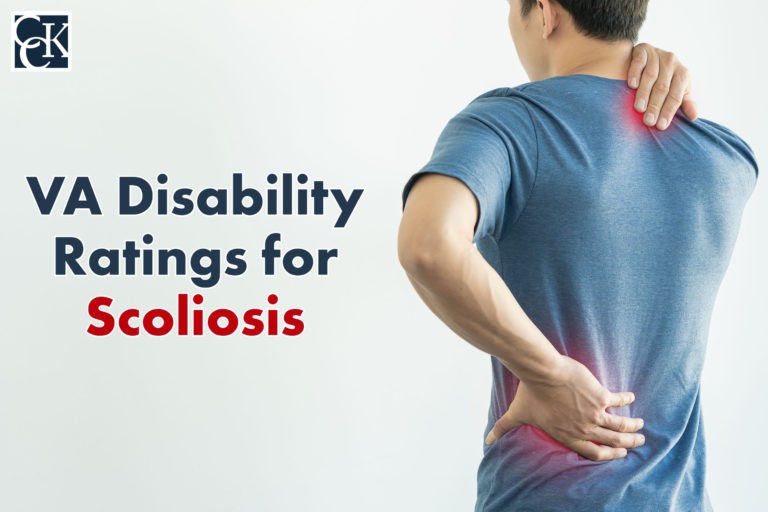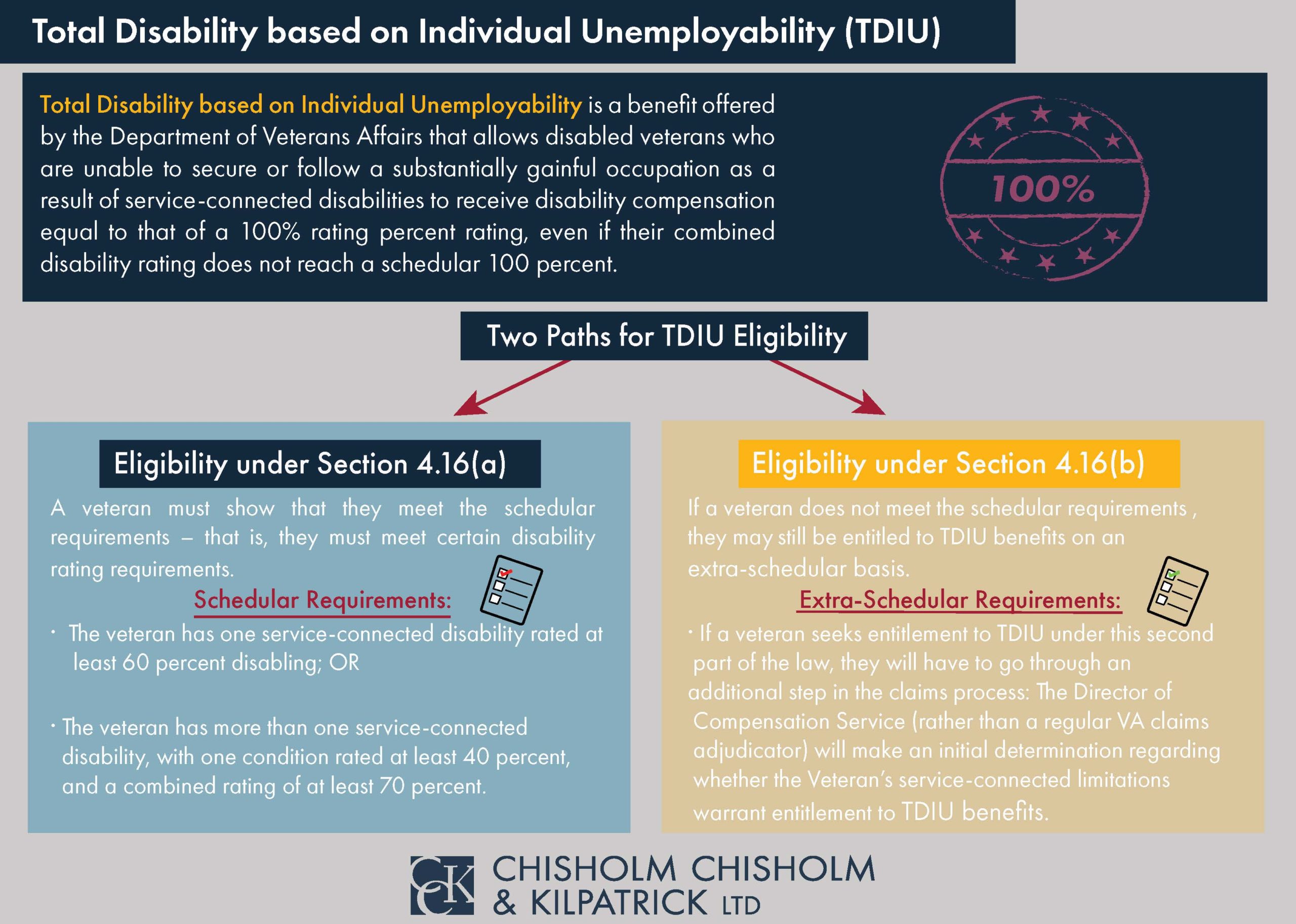VA Disability Ratings for Scoliosis

CCK Law: Our Vital Role in Veterans Law
Scoliosis is a condition that arises when the spine has an abnormal curvature. Veterans who developed scoliosis during their service may be eligible to receive VA disability benefits for their condition.
What is Scoliosis?
Scoliosis occurs when the spine has a twist or a curve. People with scoliosis may have a curve in their spine so that the spine looks more like the letters “S” or “C” rather than a straight line. The curvatures in the spine may cause the person’s shoulders or waist to appear uneven.
Scoliosis cannot be caused by poor posture or vigorous activity, contrary to popular belief. Typically, scoliosis is diagnosed in childhood or early adulthood. According to the American Association of Neurological Surgeons, scoliosis affects 2-3 percent of the United States’ population.
Forms of Scoliosis
- Congenital Scoliosis—This form of scoliosis happens as the result of embryological malformation of one, or more, of the vertebrae in any part of the spine. The location of the malformation can determine how fast, and how severely, the scoliosis progresses over time. Typically, this form of scoliosis can be detected in early childhood because it is present at birth.
- Neuromuscular Scoliosis—Neuromuscular scoliosis refers to scoliosis that is secondary to neurological or muscular conditions. Oftentimes, this form of scoliosis can be associated with cerebral palsy, spinal cord trauma, muscular dystrophy, spinal muscular atrophy and spina bifida.
- Idiopathic scoliosis—The cause idiopathic scoliosis is unknown, however it typically begins during adolescence. The curve, or curves, in the spine can progress overtime, so it is important to monitor them.

Symptoms of Scoliosis
- Uneven posture, such as one or both shoulder blades sticking out and the head not being centered directly above the pelvis
- Hips unevenly raised
- Different heights on each side of the rib cage
- Changes in skin, such as dimples, hairy patches, or color changes, in the skin surrounding the spine
- Leaning to one side
- Back pain
- Limited range of motion
- Difficulty breathing, in instances where the chest may have reduced space with not enough room for the lungs to expand
Service Connection for Scoliosis
The first step to becoming service-connected for scoliosis is to obtain a diagnosis of scoliosis from a doctor. Additionally, there will need to be a nexus, or link, between the veteran’s scoliosis and their military service. This could mean that the veteran’s service caused their scoliosis, or aggravated it. As scoliosis can be caused by spinal injuries, injuries to the spine which occurred during service may be a potential cause of scoliosis.
A nexus letter can connect the veteran’s service to their scoliosis. It will need to be provided by a medical provider, and often will draw upon medical evidence. In order to link the veteran’s condition to service, there will likely need to be evidence of an in-service event, illness, or injury. A positive medical nexus will indicate that the veteran’s scoliosis is “at least as likely as not” caused or aggravated by their service.
In order to receive VA disability benefits for scoliosis, the veteran will likely need to prove that their scoliosis often incapacitates them and causes intense back pain. Scoliosis is usually rated through limitation of range of motion, meaning that VA will likely measure how limited the veteran’s range of motion is when approving or denying the veteran’s claim.
Secondary Service Connection for Scoliosis
Secondary service connection refers to when a veteran has an already service-connected condition that caused or aggravated a secondary condition. In cases of scoliosis, the veteran may be primarily connected for a spine injury, a neurological disorder, or a muscular disorder, which then caused scoliosis.
Additionally, scoliosis has been linked to spinal stenosis and arthritis of the spine, meaning that veterans who are service-connected for scoliosis may be eligible for secondary benefits for spinal stenosis and scoliosis. Spinal stenosis is a condition that occurs when the spaces in the spine narrow, which can put pressure on the nerves in the spine. Arthritis of the spine is a breakdown of the cartilage of the joints and discs in the neck and back.
Compensation and Pension Exams (C&P) for Scoliosis
Once a claim has been filed for scoliosis, VA may request a Compensation and Pension (C&P) exam. To schedule this exam, VA will usually call the veteran or send a letter, so it is important to make sure that VA has the veteran’s most up-to-date contact information. It is also important to follow up with scheduling the exam and to attend, otherwise, VA could deny the veteran’s claim.
The exam will usually be performed by a VA physician or VA-contracted physician. Prior to the exam, the examiner will review the veteran’s c-file which will contain any documentation previously submitted to VA, as well as the veteran’s medical and service records. During the exam, the examiner may ask questions about the veteran’s service or their scoliosis. They will usually also physically examine the veteran’s spine.
The veteran may also use a DBQ, or Disability Benefits Questionnaire, to bolster their claim. A Disability Benefits Questionnaire is a form created by VA that enables veterans to address important aspects of their condition, such as symptoms, severity, possible causes, and relation to other disabilities.
Scoliosis is a condition that may be rated on how it limits a veteran’s range of motion. In these cases, the examiner may use a tool called a goniometer during the exam to obtain an accurate measurement of range of motion.
The exam itself could last anywhere from a few minutes to several hours. Once the exam is finished, the examiner will send their report to VA. The veteran may request a copy of this report for themselves.
VA Disability Ratings for Scoliosis
While scoliosis does not have its own disability rating, VA does have a general rating formula for spine conditions. In most cases, VA uses the General Rating Formula for Diseases and Injuries of the Spine, combined with the limitations on range of motion, to issue a disability rating. Under 38 CFR § 4.71a, VA generally rates low back conditions as follows:
- ”100% – unfavorable ankylosis of the entire spine
- 50% – unfavorable ankylosis of the entire thoracolumbar spine
- 40% – unfavorable ankylosis of the entire cervical spine; or, forward flexion of the thoracolumbar spine 30 degrees or less; or, favorable ankylosis of the entire thoracolumbar spine
- 30% – forward flexion of the cervical spine 15 degrees or less; or, favorable ankylosis of the entire cervical spine
- 20% – forward flexion of the thoracolumbar spine greater than 30 degrees but not greater than 60 degrees; or, forward flexion of the cervical spine greater than 15 degrees but not greater than 30 degrees; or, the combined range of motion of the thoracolumbar spine not greater than 120 degrees; or, the combined range of motion of the cervical spine not greater than 170 degrees; or, muscle spasm or guarding severe enough to result in an abnormal gait or abnormal spinal contour such as scoliosis, reversed lordosis, or abnormal kyphosis
- 10% – forward flexion of the thoracolumbar spine greater than 60 degrees but not greater than 85 degrees; or, forward flexion of the cervical spine greater than 30 degrees but not greater than 40 degrees; or, combined range of motion of the thoracolumbar spine greater than 120 degrees but not greater than 235 degrees; or, combined range of motion of the cervical spine greater than 170 degrees but not greater than 335 degrees; or, muscle spasm, guarding, or localized tenderness not resulting in abnormal gait or abnormal spinal contour; or, vertebral body fracture with loss of 50 percent of more of the height.”
Additionally, VA rates intervertebral disc syndrome (IVDS) under Diagnostic Code 5243, which focuses on the number of incapacitating episodes veterans experience as a result of their low back pain, which may be caused by scoliosis. Here, VA defines an incapacitating episode as a period of acute signs and symptoms that requires bed rest as prescribed by a physician. IVDS is rated as follows:
- “60% – with incapacitating episodes having a total duration of at least 6 weeks during the past 12 months
- 40% – with incapacitating episodes having a total duration of at least 4 weeks but less than 6 weeks during the past 12 months
- 20% – with incapacitating episodes having a total duration of at least 2 weeks but less than 4 weeks during the past 12 months
- 10% – with incapacitating episodes having a total duration of at least one week but less than 2 weeks during the past 12 months”
In this case, VA should apply the rating criteria that results in the higher evaluation for the veteran.
Scoliosis, Low Back Pain, and Flare-Ups
A flare-up is defined as a sudden and temporary increase in symptoms. Flare-ups are typically recurrent, but unpredictable and arise without warning. The abrupt escalation in symptoms, including pain and loss of mobility, can sometimes result in complete incapacitation as described above.
If the veteran becomes service-connected for a spine or back condition, the presence of flare-ups could impact the disability rating they are given. Specifically, a higher rating may be awarded when there is additional loss or limitation of motion due to pain during flare-ups. Scoliosis may cause low back pain which occurs during these flare-ups.
For example, a veteran is granted service connection for a low back condition and receives a 10 percent disability rating. On most days, the veteran is unable to bend forward more than 60 degrees. However, when experiencing a flare-up, the veteran is unable to bend more than 30 degrees. Therefore, during the flare-up, the veteran’s low back condition becomes much more disabling than 10 percent. As such, VA should assign a disability rating in accordance with this additional loss.
VA Individual Unemployability (TDIU) and Scoliosis
Veterans with scoliosis may be prevented from obtaining or maintaining substantial employment because of their condition. These veterans may be eligible for a monthly VA disability benefit called TDIU, or total disability based on individual unemployment. This benefit compensates veterans at the 100 percent rating level, even if their disability rating for their scoliosis is less than 100 percent.
There are generally two ways to seek eligibility for TDIU:
- 38 CFR § 4.16a (“Schedular”) – For this form of TDIU, the veteran must have:
- One condition rated at minimum 60 percent OR
- Two conditions that can be combined to reach 70 percent, where one condition is rated at a minimum of 40 percent.
- 38 CFR § 4.16b (“Extraschedular”) – This form of TDIU is for veterans who may not be able to achieve the ratings necessary for schedular TDIU, but are still unable to obtain substantially gainful employment on account of their conditions.
- In this instance, the veteran must prove that their condition is uniquely hinders their ability to obtain substantially gainful employment and therefore should not be rated on the standard disability rating criteria.
The rating given for service connection for scoliosis may also be combined with another condition to help the veteran achieve the criteria for schedular TDIU.
Getting Help with VA Disability Benefits for Scoliosis
Scoliosis can be a tricky condition to become service-connected for, as the condition itself does not have its own diagnostic code. If your VA disability claim for scoliosis has been denied, the accredited VA disability lawyers at Chisholm, Chisholm & Kilpatrick may be able to help. Contact us at 800-544-9144 for a free consultation to see if we can assist.
About the Author
Share this Post


